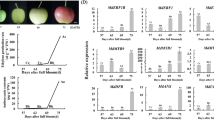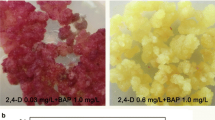Abstract
Nitrogen limitation stress is known to markedly promote anthocyanin accumulation and upregulate anthocyanin biosynthesis-related genes; however, the underlying molecular mechanisms have not been fully characterized. In this study, a callus was induced from the leaves of an R6 homozygous red-fleshed apple, the hybrid offspring of Malus sieversii f. niedzwetzkyana and Malus × domestica ‘Fuji.’ We analyzed the growth and accumulation of anthocyanin in callus under different nitrogen concentrations (0.01, 0.02, 0.04, and 0.06 M NO3 −). The results showed that the callus growth in the 0.01 M NO3 − condition was minimal, but its anthocyanin content was significantly elevated compared with those under the other nitrogen treatments. As the concentration of nitrogen increased from 0.01 to 0.04 M, the expression of the anthocyanin structural genes, MdCHS and MdDFR, and the transcription factor genes MdMYB9, MdMYB10, MdbHLH3, and MdbHLH33 were downregulated. On the contrary, the transcript levels of MdLOB52 and MdARF19 were increased by the nitrogen treatments. The overexpression of MdLOB52 inhibited anthocyanin accumulation in the callus. Subsequent yeast one-hybrid assays showed that MdARF19 can directly bind the promoter of MdLOB52, which may strengthen the activation of MdLOB52 and affect anthocyanin accumulation. Our findings provide new insights into the mechanisms by which the LOB genes respond to nitrogen to regulate anthocyanin biosynthesis in a red-fleshed apple callus.









Similar content being viewed by others
References
An JP, Li HH, Song LQ, Su L, Liu X, You CX, Wang XF, Hao YJ (2016) The molecular cloning and functional characterization of MdMYC2, a bHLH transcription factor in apple. Plant Physiol Biochem 108:24–31
Ang LH, Chattopadhyay S, Wei N, Oyama T, Okada K, Batschauer A, Deng XW (1998) Molecular interaction between COP1 and HY5 defines a regulatory switch for light control of arabidopsis development. Mol Cell 1:213–222
Bongue-Bartelsman M, Phillips DA (1995) Nitrogen stress regulates gene expression of enzymes in the flavonoid biosynthetic pathway of tomato. Plant Physiol Biochem 33:539–546
Broun P (2004) Transcription factors as tools for metabolic engineering in plants. Curr Opin Plant Biol 7:202–209
Chalfun-Junior A, Franken J, Mes JJ, Marsch-Martinez N, Pereira A, Angenent GC (2005) ASYMMETRIC LEAVES2-LIKE1 gene, a member of the AS2/LOB family, controls proximal-distal patterning in Arabidopsis petals. Plant Mol Biol 57:559–575
Chattopadhyay S, Ang LH, Puente P, Deng XW, Wei N (1998) Arabidopsis bZIP protein HY5 directly interacts with light-responsive promoters in mediating light control of gene expression. Plant Cell 10:673–683
Diaz C, Saliba-Colombani V, Loudet O, Belluomo P, Moreau L, Daniel-Vedele F, Morot-Gaudry JF, Masclaux-Daubresse C (2006) Leaf yellowing and anthocyanin accumulation are two genetically independent strategies in response to nitrogen limitation in arabidopsis thaliana. Plant Cell Physiol 47:74–83
Feild TS, Lee DW, Holbrook NM (2001) Why leaves turn red in autumn. The role of anthocyanins in senescing leaves of red-osier dogwood. Plant Physiol 127:566–574
Guilfoyle TJ, Hagen G (2001) Auxin response factors. J Plant Growth Regul 10:281–291
Hanwoo L, Nanyoung K, Dongju L, Jungmook K (2009) LOB18/ASL20 regulates lateral root formation in combination with LOB16/ASL18 downstream of ARF7. and ARF19 in arabidopsis. Plant Physiol 151:1377–1389
Honda T, Saito N (2002) ChemInform abstract: recent progress in the chemistry of polyacylated anthocyanins as flower color pigments. Cheminform 56:633–692
Ji XH, Wang YT, Zhang R, Wu SJ, An MM, Li M, Wang CZ, Chen XL, Zhang YM, Chen XS (2015a) Effect of auxin, cytokinin and nitrogen on anthocyanin biosynthesis in callus cultures of red-fleshed apple (Malus sieversii f. niedzwetzkyana). Plant Cell Tissue Organ Cult 120:325–337
Ji XH, Zhang R, Wang N, Yang L, Chen XS (2015b) Transcriptome profiling reveals auxin suppressed anthocyanin biosynthesis in red-fleshed apple callus (Malus sieversii f. niedzwetzkyana). Plant Cell Tissue Organ Culture 123:389–404
Kiba T, Kudo T, Kojima M, Sakakibara H (2011) Hormonal control of nitrogen acquisition: roles of auxin, abscisic acid, and cytokinin. J Exp Bot 62:1399–1409
Koes R, Verweij W, Quattrocchio F (2005) Flavonoids: a colorful model for the regulation and evolution of biochemical pathways. Trends Plant Sci 10:236–242
Krouk G, Lacombe B, Bielach A, Perrinewalker F, Malinska K, Mounier E, Hoyerova K, Tillard P, Leon S, Ljung K, Zazimalova E, Benkova E, Nacry P, Gojon A (2010) Nitrate-regulated auxin transport by NRT1.1 defines a mechanism for nutrient sensing in plants. Dev Cell 18:927–937
Lea US, Slimestad R, Smedvig P, Lillo C (2007) Nitrogen deficiency enhances expression of specific MYB and bHLH transcription factors and accumulation of end products in the flavonoid pathway. Planta 22:1245–1253
Lee HS, Wicker L (1991) Anthocyanins pigments in the skin of lychee fruit. J Food Sci 56:466–468
Lee J, He K, Stolc V, Lee H, Figueroa P, Gao Y, Tongprasit W, Zhao H, Lee I, Deng XW (2007) Analysis of transcription factor HY5 genomic binding sites revealed its hierarchical role in light regulation of development. Plant Cell 19:731–749
Li YY, Mao K, Zhao C, Zhao XY, Zhang HL, Shu HR, Hao YJ (2012) MdCOP1 ubiquitin E3 ligases interact with MdMYB1 to regulate light-induced anthocyanin biosynthesis and red fruit coloration in apple. Plant Physiol 160:1011–1022
Majer C, Hochholdinger F (2011) Defining the boundaries: structure and function of LOB domain proteins. Trends Plant Sci 16:47–52
Matsumoto H, Nakamura Y, Tachibanaki S, Kawamura S, Hirayama M (2003) Stimulatory effect of cyanidin 3-glycosides on the regeneration of rhodopsin. J Agric Food Chem 51:3560–3563
Matsumura Y, Iwakawa H, Machida Y, Machida C (2009) Characterization of genes in the ASYMMETRIC LEAVES2/LATERAL ORGAN BOUNDARIES (AS2/LOB) family in Arabidopsis thaliana, and functional and molecular comparisons between AS2 and other family members. Plant J 58:525–537
McDonald AJS, Davies WJ (1996) Keeping in touch: responses of the whole plant to deficits in water and nitrogen supply. Adv Bot Res 22:229–300
Monaco TA, Johnson DA, Jones TA, Redinbaugh MG (2003) Nitrogen effects on seed germination and seedling growth. J Range Manag 56:646–653
Palmer SJ, Berridge DM, Mcdonald AJS, Davies WJ (1996) Control of leaf expansion in sunflower (helianthus annuus l.) by nitrogen nutrition. J Exp Bot 47:359–368
Paola R, Mondello L, Genovese T, Morabito D, Dugo G, Sautebin L, Caputi AP, Cuzzocrea S (2003) Protective effects of anthocyanins from blackberry in a rat model of acute lung inflammation. Free Radic Res 37:891–900
Peng M, Bi YM, Zhu T, Rothstein SJ (2007) Genome-wide analysis of arabidopsis responsive transcriptome to nitrogen limitation and its regulation by the ubiquitin ligase gene nla. Plant Mol Biol 65:775–797
Rajendran L, Suvarnalatha G, Ravishankar GA, Venkataraman LV (1994) Enhancement of anthocyanin production in callus cultures of Daucus canota, l. under the influence of fungal elicitors. Appl Microbiol Biotechnol 42:227–231
Rossi A, Serraino I, Dugo P, Di PR, Mondello L, Genovese T, Morabito D, Dugo G, Sautebin L, Caputi AP, Cuzzocrea S (2003) Protective effects of anthocyanins from blackberry in a rat model of acute lung inflammation. Free Radic Res 37:891–900
Rubin G, Tohge T, Matsuda F, Saito K, Scheible WR (2009) Members of the LOB family of transcription factors repress anthocyanin synthesis and affect additional N responses in Arabidopsis. Plant Cell 21:3567–3584
Sattelmacher B, Klotz F, Marschner H (1990) Influence of the nitrogen level on root growth and morphology of two potato varieties differing in nitrogen acquisition. Plant Soil 123:131–137
Sevimli-Gur C, Burcu C, Akay S, Gulce-Iz S, Yesil-Celiktas O (2013) Extracts from black carrot tissue culture as potent anticancer agents. Plant Foods Hum Nutr 68:293–298
Shuai B, Reynaga-Pena CG, Springer PS (2002) The lateral organ boundaries gene defines a novel, plant-specific gene family. Plant Physiol 129:747–761
Stewart AJ, Chapman W, Jenkins GI, Graham I, Martin T, Crozier A (2001) The effect of nitrogen and phosphorus deficiency on flavonol accumulation in plant tissues. Plant Cell Environ 24:1189–1197
Sun SB, Song JP, Meng LS (2012) ASYMMETRIC LEAVES2 gene, a member of LOB/AS2 family of Arabidopsis thaliana, causes an abaxializing leaves in transgenic cockscomb. Mol Biol Rep 39:4927–4935
Takei K, Takahashi T, Sugiyama T, Yamaya T, Sakakibara H (2002) Multiple routes communicating nitrogen availability from roots to shoots: a signal transduction pathway mediated by cytokinin. J Exp Bot 53:971–977
Tsuda T, Horio F, Uchida K, Aoki H, Osawa T (2003) Dietary cyaniding 3-O-beta-D-glucoside-rich purple corn color prevents obesity and ameliorates hyperglycemia in mice. J Nutr 133:2125–2130
Yordanov YS, Regan S, Busov V (2010) Members of the LATERAL ORGAN BOUNDARIES DOMAIN transcription factor family are involved in the regulation of secondary growth in Populus. Plant Cell 22:3662–3677
Zhou LL, Shi MZ, Xie DY (2012) Regulation of anthocyanin biosynthesis by nitrogen in TTG1–GL3/TT8–PAP1-programmed red cells of Arabidopsis thaliana. Planta 236:825–837
Acknowledgements
This work was supported by the Special Fund for Agro-Scientific Research in the Public Interest (201303093), the National Natural Science Foundation of China (CN) (31572091), and the National Key Research and Development project (2016YFC0501505).
Author information
Authors and Affiliations
Contributions
Conceived and designed the experiments: YCW, NW, and XSC. Conducted the experiments: YCW. Analyzed the data: YCW and XSC. Wrote the manuscript: YCW, ZYZ, NW, and XSC.
Corresponding author
Ethics declarations
Conflict of interest
The authors declare no conflict of interest.
Electronic supplementary material
Below is the link to the electronic supplementary material.
Rights and permissions
About this article
Cite this article
Wang, Y., Wang, N., Xu, H. et al. Nitrogen Affects Anthocyanin Biosynthesis by Regulating MdLOB52 Downstream of MdARF19 in Callus Cultures of Red-Fleshed Apple (Malus sieversii f. niedzwetzkyana). J Plant Growth Regul 37, 719–729 (2018). https://doi.org/10.1007/s00344-017-9766-7
Received:
Accepted:
Published:
Issue Date:
DOI: https://doi.org/10.1007/s00344-017-9766-7




